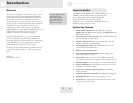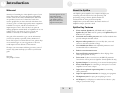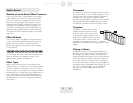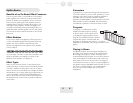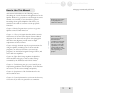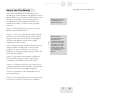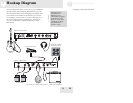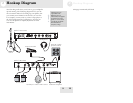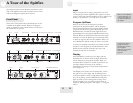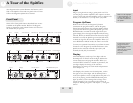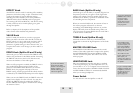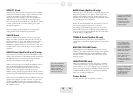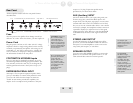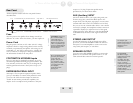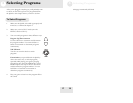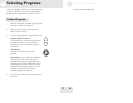
3 A Tour of the Spitfire
11
Input
Program Up/Down
Display
EFFECT Knob
VALUE Knob
DRIVE Knob
BASS Knob
TREBLE Knob
MASTER VOLUME Knob
HEADPHONES Jack
Power Switch
Input
Program Up/Down
Display
EFFECT Knob
VALUE Knob
DRIVE Knob
MASTER VOLUME Knob
HEADPHONES Jack
Power Switch
Input
Program Up/Down
Display
EFFECT Knob
VALUE Knob
MASTER VOLUME Knob
HEADPHONES Jack
Power Switch
The diagrams in this section illustrate the features you’ll
find on the Spitfire’s front and rear panels. The text that
follows the diagrams explains those features.
Front Panel
Some of the front-panel features described here are not
available on all Spitfire models. Refer to the diagram
below to determine exactly which features are found on
the model that you possess.
3 A Tour of the Spitfire
12
Input
Plug in your guitar here using a guitar patch cord. You
can also plug in another amplifier’s line output in order to
create a stereo link with that amplifier (refer to chapter 9 for
details). You should use a 1/4” tip-sleeve (TS) cable.
Program Up/Down
While in PLAY mode, the Program Up button
increments the program number, and the Program
Down button decrements the program number. When
you press both buttons together, the Spitfire goes into
BYPASS mode, in which the audio signal from your
guitar simply passes through the Spitfire without being
affected. When you hold both buttons down for longer
than half a second, the Spitfire goes into MUTE mode,
in which no signal at all leaves the amplifier. When you
are in BYPASS or MUTE mode, the tuner is activated.
You may use optional footswitches to perform the same
functions as the Program Up and Down buttons. The
Spitfire works with both normally open (NO) and
normally closed (NC) footswitches.
Display
This LED display is made up of two digits and two
decimal points. In PLAY mode the digits indicate the
current bank letter and program number. When you
turn the EFFECT knob to a module or parameter, the
two digits display the setting of the selection.
Descriptions of settings for each mode and parameter
are in chapter 10.
The Display also contains two decimal points, each to
the right of one of the digits. The # decimal point is
used by the Spitfire’s tuner to help indicate the pitch of a
note you’re playing, and the EDITED decimal point
lights up when you have changed the settings of the
current program. You can read more about these in
chapter 5 “Editing Programs” and chapter 7, “Using the
Tuner.”
M
ake sure the amplifier
is turned off before you
connect your guitar or
any other instrument to
the Spitfire.
F
ootswitches must be
plugged in and not
pressed when you turn
on the Spitfire.
Otherwise, the switches
may not function
properly.



